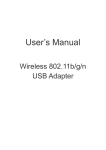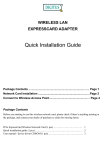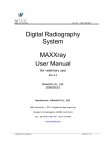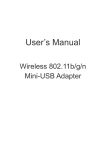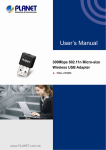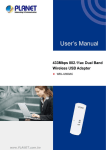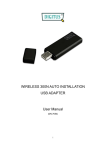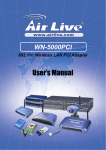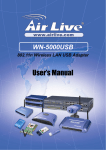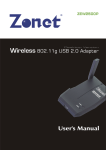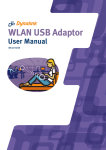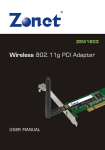Download CWD-905 Wireless-N USB Dongle User Manual
Transcript
CWD-905 Wireless-N USB Dongle User Manual Version: 1.0 (July, 2007) Table of Contents Chapter 1: Introduction ...........................................................................................3 1.1 About CWD-905 .....................................................................................3 1.2 Main Features.........................................................................................3 1.3 System Requirements..........................................................................4 1.4 Getting to Know CWD-905 ..................................................................4 Chapter 2: Driver Installation and Configuration .............................................5 2.1 USB Adapter Installation .....................................................................5 2.2 Connect to Wireless Access Point .................................................12 2.3 Connection Profile Management.....................................................22 2.4 View Network Statistics and Link Status.......................................34 2.5 Advance Settings ................................................................................38 2.6 QoS Settings.........................................................................................41 2.7 WPS Configuration..............................................................................44 2.8 About ......................................................................................................50 Chapter 3: APPENDIX ............................................................................................52 3.1 Troubleshooting...................................................................................52 3.2 Glossary.................................................................................................53 2 Chapter 1: Introduction 1.1 About CWD-905 Thank you for purchasing this high-speed 802.11 b/g/n (Draft 2.0) wireless USB dongle. The Wireless-N USB Dongle can be installed in most notebooks or desktops and provides true flexibility by allowing the computer to be positioned almost anywhere in the building without the cost and hassle of running network cables. Using the wireless USB dongle, you don't have to worry about drilling holes in your walls and climbing through the attic or cellar to get connected to the network. Once installed and connected, you can keep in touch with friends and work through e-mail, instant messaging and chat rooms as well as sharing files and other network resources such as printers and network storage with other computers. The Wireless-N USB Dongle connects to 802.11n networks at an incredible speed of 300Mbps! And for added versatility, it also interoperates with all Wireless-G and B products found at homes, businesses, and public wireless hotspots around the country. 1.2 Main Features The following lists the main features of the Wireless-N USB Dongle. • Complies with IEEE 802.11n Draft 2.0 and IEEE 802.11g/b standards • 6 times faster speeds than Wireless-G • Interoperates with existing Wireless-G/B equipments • Advanced WPA (Wi-Fi Protected Access) encryption, 64/128-bit WEP and AES/TKIP provide maximum wireless security • Cisco CCX V1.0, V2.0 and V3.0 compliance • Supports operating system: Windows 2000/XP/XP64/Windows Vista • Ease of Installation and Use 3 1.3 System Requirements • An empty USB 2.0 port (May not work on USB 1.1 port, and performance will be greatly reduced) • Windows 2000, XP, or Vista operating system • CD-ROM drive • At least 100MB of available disk space 1.4 Getting to Know CWD-905 1. USB Connector 2. Connector Cap (To protect USB connector when not in use) 3. Link/Activity LED LED Name Light Status Description Link/ On Linked to a wireless access point / Activity Transferring data Off No wireless activity 4 Chapter 2: Driver Installation and Configuration 2.1 USB Adapter Installation Please follow the following instructions to install your new wireless USB dongle: 1. Insert the wireless USB dongle into an empty USB 2.0 port of your computer when computer is switched on. Never use force to insert the USB device, if you feel it’s stuck, flip the USB device over and try again. 5 2. The following message will appear on your computer, click ‘Cancel’. 3. Insert the Auto-Install CD into your CD-ROM drive. Unless you have disabled the auto-run feature of Windows, the AutoPlay Menu should appear automatically. If not, you can manually access the installation by clicking the Start button and choosing Run. In the drop-down box type D:\ AUTORUN.EXE (where D: is the drive letter for your CD-ROM drive). Alternately, double-click My Computer and double-click on the CD drive icon. Click on CWD-905 to install driver and utility for your wireless network card. 6 4. Insert device driver CDROM into the CD/DVD ROM drive of your computer, and execute ‘Setup.exe’ program in ‘Driver’ folder. Please read the end user license agreement and click ‘Yes’ to accept license agreement. 5. You can choose the configuration tool used to configure the wireless network card here. It’s recommended to select ‘Ralink Configuration Tool’, which provides fully access to all function of this wireless network card. If you prefer to use the wireless configuration tool provided by Windows XP or Vista, please select ‘Microsoft Zero Configuration Tool’, then click ‘Next’. 7 6. There are two wireless performance mode you can select here: Optimize for WiFi mode or Optimize for performance mode If you want to enhance wireless performance, please select ‘Optimize for performance mode’. However, wireless compatibility is not guaranteed in this mode. If you want to use this mode, you may not be able to communicate with older wireless devices and wireless access point, such as 802.11b devices, but the data transfer rate will be enhanced in this mode. You can select this mode when you only plan to communicate with 802.11 Draft-N devices. If you want to keep compatibility and communicate with older wireless devices, please select ‘Optimize for WiFi Mode’. When you select one mode, please click ‘Next>’ to continue. If you see ‘Found New Hardware’ message again, please ignore it and wait. 8 7. Please click ‘Install’ to run the driver installation process. 8. When you see this message, please click ‘Finish’ to complete the driver installation process. 9 10 9. A new icon will appear at lower-right corner of your computer desktop, you can put the mouse cursor on the icon, and the status of wireless card will be displayed as a popup balloon. HERE! 10. When you want to configure your wireless connection, please right click on this icon, and a popup menu will appear. You can click ‘Launch Config Utilities’ to start configuration program. If you want to close configuration utility, please click ‘Exit’. 11 2.2 Connect to Wireless Access Point There are two ways you can configure your wireless network card to connect to wireless access point: using the Ralink configuration utility which comes with wireless card driver, and using built-in windows zero configuration utility. 2-2-1 Using Ralink Utility Please follow the following instructions to use Ralink configuration utility to connect to wireless access point. 1. Right-click the Ralink configuration utility icon located at lower-right corner of computer desktop, then click ‘Launch Config Utilities’. 2. Configuration utility will scan for all wireless access points automatically. Scan results will be displayed here, please check if the wireless access point with the SSID (the name of wireless access point) you preferred is shown here. If the wireless access point you wish to connect does not show here, please click ‘Rescan’ to try again, until the one you preferred is displayed. You may have to click ‘Rescan’ for more than two times before you can see the access point you wish to use here sometimes. If you still cannot see the access point you wish to use after clicking ‘Rescan’ for more than five times, please move your computer closer to the location where the wireless access point is. 12 Here are descriptions of every setup item: SSID: The Service Set IDentifier of wireless access point or other network device. You can think it as the name of access point of wireless device. BSSID: The MAC address of wireless access point or other network device. Unlike SSID, BSSID of every access point or network device is unique, and will not be the same with others. So you can identify a single access point or wireless device from others by BSSID, if they all have the same SSID. Signal: Shows the signal strength of access point or wireless device. Larger number means better radio strength, which often means you’re not too far from that access point or wireless device. Channel: Shows the channel number that access point or wireless device 13 uses. Encryption: Shows the encryption method that access point or wireless device uses. If the wireless access point does not enable encryption, you’ll see ‘None’ displayed here. Authentication: Shows the authentication mode that access point or wireless device uses. If the wireless access point does not require authentication, you’ll see ‘Unknown’ displayed here. Network Type: Shows the type of wireless connection. If it’s a wireless access point, ‘Infrastructure’ will be displayed here; if it’s a computer or network device, ‘AdHoc’ will be displayed here. Tips: Wireless access point (Infrastructure) is a network device which acts as a bridge, to let wired and wireless network devices communicate with each other. AdHoc is another connection type. A computer or network device can establish a direct wireless link with other computer or network device directly, without the help of wireless access point. 3. Click the wireless access point or network device you wish to connect, it will be highlighted, then click ‘Connect’. Note: There is no Connect button in Window Vista. You have to use the Add Profile feature to build the wireless connection with the selected network. Please refer to the Profile information. 14 If the access point you selected does not enable encryption (The content of ‘Encryption’ field of the access point you selected is ‘None’, you’ll be connected to this wireless access point within one minute. Please jump to step 6. If the access point you selected enables encryption, please proceed to next step. 4. If the wireless access point does not have SSID, you’ll be prompted to input it here. Please ask the owner of wireless access point and input the exact SSID here, then click ‘OK’ when ready. If the SSID you provided here is wrong, you’ll not be able to connect to this access point. If the wireless access point you selected have SSID, please skip this step. 15 5. If the wireless access point uses encryption, you have to input WEP passphrase or WPA preshared key. Please ask the owner of the wireless access point you want to connect, and input the correct passphrase / preshared key here, then click ‘OK’. If the value you inputted here is wrong, you will not be able to connect to this wireless access point. Authentication type is selected automatically, please don’t change it. If the access point you selected does not enable encryption and does not require authentication, please skip this step. 6. You’ll see ‘Connected <-> SSID’ (‘SSID’ is the SSID of the wireless access point or 16 wireless device you connected to) message displayed at lower-left corner of configuration utility, congratulations, you’re successfully connected to the access point or wireless device you selected! 7. You can put the mouse cursor over the Ralink configuration utility icon, and the brief information about link status and signal strength of current wireless connection will be shown as a popup balloon. 17 2-2-2 Using Windows Zero Configuration Windows XP and Vista has a built-in wireless network configuration utility, called as ‘Windows Zero Configuration’ (WZC). You can also use WZC to configure your wireless network parameter: 1. Right-click Ralink configuration utility icon and select ‘Use Zero Configuration as Configuration utility. 2. Click ‘Start’ button (should be located at the bottom-left corner of windows desktop), click ‘Control Panel’, then click ‘Network and Internet Connections’ in Control Panel. 18 3. Click ‘Connect to a network’ under ‘Network Connections’ 4. Right-click ‘Wireless Network Connection’ (it may have a number as suffix if you have more than one wireless network card, please make sure you right-click the ‘Ralink 802.11n Wireless LAN Card), then select ‘View Available Wireless Networks’. 5. All wireless access points in proximity will be displayed here. If the access point you want to use is not displayed here, please try to move your computer closer to the access point, or you can click ‘Refresh network list’ to rescan access points. Click the access point you want to use if it’s shown, then click ‘Connect’. 19 6. If the access point is protected by encryption, you have to input its security key or passphrase here. It must match the encryption setting on the access point. If the access point you selected does not use encryption, you’ll not be prompted for security key or passphrase. 7. If you can see ‘Connected’ message, the connection between your computer and wireless access point is successfully established. 20 21 2.3 Connection Profile Management If you need to connect to different wireless access points at different time, like of access point of your home, office, cybercafe, or public wireless service, you can store the connection parameters (encryption, passphrase, security etc, etc.) as a profile for every access point, so you don’t have in input these parameters every time you want to connect to a specific wireless access point. 2-3-1 Make a profile for an access point or wireless device 1. Right-click the Ralink configuration utility icon located at lower-right corner of computer desktop, then click ‘Launch Config Utilities’. 2. There are two ways to add a new connection profile: Create a new profile, or Add a profile from an existing wireless access point or wireless device If you want to click new profile, click ‘Profile’ tab, then click ‘Add’ button: 22 Or, you can add a connected wireless access point or wireless device to a profile by clicking ‘Site Survey’ tab, then click ‘Add to Profile’ button: 23 And you can set the parameter for this connection here: 24 Here are descriptions of every setup items: Profile Name Please give this profile a name, up to 32 alphanumerical characters and symbols are allowed, but space is not allowed. SSID The SSID of the wireless access point or wireless device you selected will be displayed here. But if the SSID of access point or wireless device is not available, you have to input it here manually. PSM: Please select CAM (constantly awake mode, keep (Power Saving the wireless radio activity when not transferring Mode) data), or PSM (Power saving mode, switches radio off when not transferring data). It’s recommended to choose ‘PSM’ if you’re using this network card with notebook computer to help the battery live longer. Network Type Select network type (‘Ad Hoc’ or ‘Infrastructure’). If you’re adding a profile from an existing access point or wireless device, it’s automatically selected and you don’t have to change it. TX Power You can select the radio output power of wireless network card. You may not need full radio power if you’re not far from wireless access point, and only use a high setting here if you found that radio reception is bad. If you don’t know which one to use, select ‘Auto’. Preamble This option is only available when the network type is ‘Ad hoc’. You can select ‘Auto’ or ‘Long Preamble’. Please select ‘Auto’ if you don’t know what it is. RTS Threshold Check the box and you can set RTS threshold manually here. Do not modify default setting unless you know what it is. Fragment Check the box and you can set fragment threshold Threshold manually here. Do not modify default setting unless you know what 25 it is. Now click ‘Authentication and Security’ tab, and set the encryption and authentication settings. Here are descriptions of every setup items: Authentication Select the authentication type of the wireless access Type point or wireless device you wish to connect. If you’re adding a profile from an existing access point or wireless device, the value will be selected automatically, and please do not modify it. If you select ‘LEAP’, the following message will be displayed. Please input LEAP identity, password, domain name, and select encryption type. You can check ‘Show Password’ box so the password you inputted will be displayed as you type, but not replace by asterisk. 26 Encryption: Select the encryption type of the wireless access point or wireless device you wish to connect. If you’re adding a profile from an existing access point or wireless device, the value will be selected automatically, and please do not modify it. WPA Input WPA preshared key here. If encryption is not Preshared Key enabled, or you select ‘WEP’ as encryption type, this field will be disabled and grayed out. WEP Key You can select key type (Hex or ASCII) and input WEP key here. If encryption is not enabled, or you select ‘WPA’ as encryption type, this field will be disabled and grayed out. Show Password Check this box and all passphrases or security keys you inputted will be displayed as you type, but not replace your input with asterisk. 27 Use 802.1x Enable 802.1x wireless authentication. Please click ‘802.1x Setting’ button to set 802.1x parameters. (See next section). After you finish all settings, click ‘OK’ to save settings and exit. The profile you just created will be displayed: 28 Select the profile you wish to use, and click ‘Activate’ to use the profile you selected. You can only activate a profile a time, and the profile which is activated currently will have a green check ( ) before its name. If the wireless access point is not reachable, a red check ( ) will be displayed before its name. If you want to change the connection parameters of a specific profile, just select it and click ‘Edit’ button, you’ll be prompted to input the connection parameters, just like you’re creating a new profile. If you no longer need a profile, select the profile then click ‘Delete’. 29 2-3-2 Using 802.1x – Certification After you click ‘802.1x Setting’, a new window will appear: Here are descriptions of every setup items: Authentication Please select an 802.1x authentication type here. Type The type you select here must be identical to the type of the 802.1x authentication type you’re using. Session You can enable or disable session resumption here. Resumption If you don’t know if you should enable session resumption or not, please ask your 802.1x authentication administrator. Identity Please input 802.1x identity here. Password Please input the password of 802.1x identity here. 30 Domain Name Please input the domain name of 802.1x authentication here. This field will be grayed out when authentication type is not ‘EAP-FAST’. Use Client If the authentication type you use is ‘PEAP’ or ‘TTLS’, you can use the certificate stored on your computer. If the authentication type you use is ‘TLS/Smart Card’, this box is always checked. More.. After you clicked this button, you’ll be prompted to select a certificate on your computer. Allow This box is always checked and can not be modified. unauthenticated provision mode Use protected If the authentication type you use is ‘EAP-FAST’ authentication you can use protected authentication credential credential by check this box. Remove Remove the credential you imported previously. Import Import the authentication credential file (PAC or al file format), you’ll be prompted to select a credential file from your computer. Protocol You can select the protocol of tunneled authentication here. This pulldown menu is only available when authentication type you use is ‘PEAP’ or ‘TTLS’. When you use ‘EAP-FAST’ as authentication type, the protocol setting is always ‘Generic Token Card’ and can not be changed. Identity Please input the identity of tunneled authentication (of tunneled here. authentication) 31 Password Please input the password of tunneled authentication (of tunneled here. authentication) Password Mode Please select the password mode of ‘EAP-FAST’ authentication mode. This setting is hidden when the authentication type is not ‘EAP-FAST’. After you finish all settings, click ‘OK’ to save settings and exit. 32 2-3-3 Using 802.1x - CA Server If you want to use CA server, please click ‘CA Server’ tab. And the following message will be displayed: Here are descriptions of every setup items: Use certificate Check this box to enable the use of certificate chain. chain Certificate Please select the issuer of certificate from this Issuer dropdown menu. Allow Check this box if you wish to allow intermediate intermediate certificates. certificates Server name Input the server name of CA server here. Server name Check this box and the wireless configuration must match utility will check if the server name of CA server exactly you set here is exactly matched with the CA server connected to. If they don’t match, connection will be dropped. Domain name Check this box and the wireless configuration utility must end will check the end of domain name. If there’s in specified name anything wrong, connection will be dropped. After you finish all settings, click ‘OK’ to save settings and exit. 33 2.4 View Network Statistics and Link Status The configuration utility provides information about network statistics and link status. If you want to know how your wireless network card works, you can use these functions to get detailed information about the wireless connection you’re using. 2-4-1 Network Statistics Please follow the following instructions to check network statistics: 1. Right-click the Ralink configuration utility icon located at lower-right corner of computer desktop, then click ‘Launch Config Utilities’. 2. Click ‘Statistics’ tab, and the statistics of wireless connection will be displayed: All connection-related statistics is displayed here. You can click ‘Reset Counter’ to reset 34 the statistics of all items back to 0. Click ‘OK’ to close the window. 35 2-4-2 Link Status Please follow the following instructions to check network statistics: 1. Right-click the Ralink configuration utility icon located at lower-right corner of computer desktop, then click ‘Launch Config Utilities’. 2. Click ‘Link Status’ tab, and information about current wireless connection will be displayed: 36 These information displayed here are updated every second, and here are descriptions of every item: Status Displays the SSID and BSSID of connected wireless access point or wireless device (displayed as SSID <-> BSSID as shown in above picture. If there’s no active connection currently, ‘Disconnected’ will be displayed here. Extra Info Displays the link status (‘Link is up’ or Link is down’, and the radio transmitting power of your network card. Channel Displays the radio channel being used now. Link Speed Displays the link speed of data transmitting (Tx, in Mbps) and receiving (Rx, in Mbps). Link speed is the maximum available data transfer speed of the wireless connection, and depends on the radio signal quality of wireless connection. Throughput Displays the rate of data transmitting (Tx, in Kbps) and receiving (Rx, in Kbps). Link Quality Displays link quality (radio signal quality). When the link quality is better, the wireless link speed will be better, too. Link quality is displayed by percentage and a descriptive word (Good, normal, weak, and low). Signal Strength 1 Displays the radio signal strength of built-in antenna 1. Signal Strength 2 Displays the radio signal strength of built-in antenna 2. Noise Level Displays the percentage or level of noise (unusable) signal. If the value of this item is high, data transfer rate will drop. dBm Check this box and the value of signal strength and noise level will be displayed in dBm level instead of percentage. There are several wireless statuses available at the bottom of this window. 37 2.5 Advance Settings This wireless network card provides several advanced settings for experienced wireless users. You can change these settings to increase data transfer performance, or change operation mode. Please follow the following instructions to set advanced wireless settings: 1. Right-click the Ralink configuration utility icon located at lower-right corner of computer desktop, then click ‘Launch Config Utilities’. 2. Click ‘Advanced’ tab, and the following settings will appear: 38 Here are descriptions of every setup items: Wireless mode Select wireless operation mode, available options are 802.11 B/G mix, 802.11 B only, and 802.11 B/G/N mix. You can select 802.11 B/G/N mix to maximize wireless compatibility with wireless access points and other wireless devices. Anyway, you can set this setting to ‘802.11 B only’ when you’re going to communicate with old 802.11b wireless devices and you got problem using other two modes. Wireless This setting helps your network card to avoid Protection interference with other wireless devices when there are both 802.11b and 802.11g wireless devices in the same place. It’s recommended to set this setting to ‘Auto’ , since enabling this setting will slightly reduce the data transfer performance. TX Rate Normally, the wireless network card will adjust transfer rate automatically according to wireless signal quality. However, you can fix the data transfer rate to a lower fixed rate if you think there’s some problem about data transfer, or you’re too far from wireless access point. It’s recommended to set this setting to ‘Auto’, unless you really know the meaning of this setting. Tx BURST Check this box to accelerate the data transmit rate. It may not work with all wireless access point and wireless devices. Enable TCP Check this box and the configuration utility will Window Size adjust TCP window size automatically, to get better performance. It should be safe for most of wireless environments, but if you found some problem on data transfer, uncheck this box. Fast Roaming at Check this box and you can adjust the threshold of when this wireless network card should switch to another wireless access point with better signal quality. Only adjust value when you understand what it means. Turn off RF Click this button to switch wireless radio off, click it again switch wireless radio on. 39 Select Your Select the country / region code of the place you’re Country Region living. Different country / region has different Code regulations on wireless devices, and it’s forbidden to use certain channel (radio frequency) in some countries or regions. Please select the country and region code according to the place you live. Show When your computer is being authenticated by Authentication wireless authentication server, a dialog window Status Dialog with the process of authentication will appear. This function is helpful to find out the problem when you can not be authenticated, and you can provide this information to authentication server’s administrator for debugging purpose. Enable CCX Enable Cisco Compatible eXtensions. CCX is a wireless feature developed by Cisco used to improve the wireless performance with CCX compatible wireless devices. Check this box if you need to connect to CCX-compatible wireless devices. Turn on CCKM Check this box to enable CCKM (Cisco Centralized Key Management), which enables wireless clients to roam between CCKM-enabled access points in very short time. Enable Radio When you’re connecting to CCX-compatible Measurement access point, check this box to enable radio measurement function to improve wireless connectivity. Non-Serving When you’re connecting to CCX-compatible Channel access point, check this box to enable measurement Measurements on unused radio channels to improve wireless connectivity. Limit --- Limit the time used for said measurement to a milliseconds certain time. Default value is 250. After you finish the settings, click ‘Apply’ to apply new settings, and click ‘OK’ to close configuration utility. 40 2.6 QoS Settings This wireless network card provides QoS (Quality of Service) function, which can improve the performance of certain network applications, like audio / video streaming, network telephony (VoIP), and others. When you enable WMM (Wi-Fi MultiMedia) function of this network card, you can define the priority of different kinds of data, to give higher priority to applications which require instant responding. Therefore you can improve the performance of such network applications. Please follow the following instructions to set advanced wireless settings: Right-click the Ralink configuration utility icon located at lower-right corner of computer desktop, then click ‘Launch Config Utilities’. Click ‘QoS’ tab, and the following settings will appear: 41 Here are descriptions of every setup items: WMM Enable Check this box to enable WMM function. Please click ‘Apply’ button on the right of this check box after you check or uncheck this box, so corresponding settings in this window will be activated or deactivated respectively. WMM - Power Enable WMM power saving mode to save energy Save Enable and lets your battery live longer. Setting... Click this button to select the WMM data type which will suppress the function of power saving. When this kind of data is transferring, power saving function will be disabled. Available data types are AC_BK (Background / Low Priority), AC_BE (Best Effort), AC_VI (Video First), and AC_VO (Voice First). 42 Direct Link Enable or disable direct link setup (DLS) function. Setup Enable This function will greatly improve the data transfer rate between WMM-enabled wireless devices. Please click ‘Apply’ button on the right of this check box after you check or uncheck this box, so corresponding settings in this window will be activated or deactivated respectively. MAC Address Input the MAC address of another WMM-enabled wireless device you wish to establish a direct link here, then click ‘Apply’ to add this MAC address to DLS address table. Timeout Value Input the timeout value of this WMM-enabled direct link wireless device. If the wireless device is not responding after this time, it will be removed from DLS table. Tear Down If you want to remove a specific wireless device from DLS table, select the device and click this button to remove it. After you finish the settings, click ‘OK’ to close configuration utility. 43 2.7 WPS Configuration Wi-Fi Protected Setup (WPS) is the latest wireless network technology which makes wireless network setup become very simple. If you have WPS-enabled wireless access point, and you want to establish a secure connection to it, you don’t have to configure the wireless access point and setup data encryption. All you have to do is go to the WPS setup page of this wireless card, click a button (if your wireless card has a hardware WPS button, you can also simply push the hardware WPS button on the wireless card), and then press a specific button on the wireless access point you wish to establish a secure connection - just three simple steps! For older wireless access points, it’s possible to perform a firmware upgrade to become a WPS-enabled access point. Since they may not have a hardware button to press for WPS setup, you can use an alternative WPS setup method – input the pin code. Every WPS-compatible wireless network card comes with a unique WPS pin code; you can just input the code to wireless access point, and the wireless access point and wireless network card will do the rest for you. This wireless network card is compatible with WPS. To use this function, the wireless access point you wish to connect to must support WPS function too. Now, please follow the following instructions to establish secure connection between WPS-enabled wireless access point and your wireless network card: 44 2-7-1 WPS Setup - PBC (Push-Button Configuration) 1. Right-click the Ralink configuration utility icon located at lower-right corner of computer desktop, then click ‘Launch Config Utilities’. 2. Click ‘WPS Configuration’ tab, and the following settings will appear: 45 3. Push the ‘WPS’ button on your wireless access point (the button used to activate WPS standby mode may have another name), or use other way to start WPS standby mode as the instruction given by your wireless access point’s user manual. 4. Before you start to establish the wireless connection by using WPS, you can click ‘Rescan’ button to search for WPS-enabled access points near you, to make sure the WPS function of your access point is activated. All access points found will be displayed. Please make sure the access point you wish to connect is displayed. If not, please click ‘Rescan’ few more times. You can also click ‘Information’ button to see the detailed information about selected access point. 5. Click ‘PBC’ button now to start to establish wireless connection by WPS, and please be patient (This may require several seconds to one minute to complete). When you see ‘WPS status is connected successfully’ message, means the connection between your wireless 46 network card and access point is successfully connected by WPS, and the information about access point you connected to will be displayed. TIPS: You can push ‘WPS’ button on network card too, it’s the same as the ‘PBC’ button in configuration utility. Sometime WPS may fail, and you can click ‘PBC’ button few more times to try again. When an access point is connected, you can click ‘Disconnect’ to disconnect your wireless network card from a connected access point, or select another WPS-enabled wireless access point, then click ‘Connect’ to establish connection to selected access point, if there are more than one WPS-enabled access point found. You can also click ‘Rotate’ button, and next access point on the list will be selected to establish connection. If you want to delete a found access point from the list, select it and click ‘Delete’ button. 2-7-2 WPS Setup - PIN If the wireless access point you wish to connect supports PIN, please follow the following instructions to establish connection to it: 1. Right-click the Ralink configuration utility icon located at lower-right corner of computer 47 desktop, then click ‘Launch Config Utilities’. 2. Click ‘WPS Configuration’ tab, and the following settings will appear: The PIN number of your wireless network card is an eight-digit number located at the upper-right position of configuration utility. Remember it, and input the number to your wireless access point as the WPS PIN code (Please refer to the user manual of your wireless access point for instructions about how to do this). NOTE: The PIN code of every wireless network card is DIFFERENT. Please don’t use the sample code shown here. 48 3. Click ‘PIN’ button now, and wait for few seconds to one minute. If a wireless access point with correct PIN code is found, you’ll be connected to that access point: You may have to click ‘PIN’ for few more times to try again. If you still can not connect to access point by this way, please make sure the PIN code you provided to access point is correct. 49 2.8 About The ‘About’ tab provides you the information about version numbers of configuration utility, firmware, and other important information about your wireless network card. Please follow the following instructions to see these information: 1. Right-click the Ralink configuration utility icon located at lower-right corner of computer desktop, then click ‘Launch Config Utilities’. 2. Click ‘About’ tab, and the following settings will appear: 50 The About screen shows release dates as well as driver/utility versions and the MAC/IP address of the card. Please click ‘OK’ to close configuration utility. 51 Chapter 3: APPENDIX 3.1 Troubleshooting If you encounter any problem when you’re using this wireless network card, don’t panic! Before you call your dealer of purchase for help, please check this troubleshooting table, the solution of your problem could be very simple, and you can solve the problem by yourself! Scenario Solution I can’t find any wireless access 1. Click ‘Rescan’ for few more times and see if you can point / wireless device in ‘Site Survey’ function. find any wireless access point or wireless device. 2. Please move closer to any known wireless access point. 3. ‘Ad hoc’ function must be enabled for the wireless device you wish to establish a direct wireless link. 4. Please adjust the position of network card (you may have to move your computer if you’re using a notebook computer) and click ‘Rescan’ button for few more times. If you can find the wireless access point or wireless device you want to connect by doing this, try to move closer to the place where the wireless access point or wireless device is located. Nothing happens when I click ‘Launch config utilities’ 1. Please make sure the wireless network card is inserted into your computer’s USB port. If the Ralink configuration utility’s icon is black, the network card is not detected by your computer. 2. Reboot the computer and try again. 3. Remove the card and insert it into another USB port. 4. Remove the driver and re-install. 5. Contact the dealer of purchase for help. I can not establish connection 1. Click ‘Connect’ for few more times. with a certain wireless access 2. If the SSID of access point you wish to connect is point hidden (nothing displayed in ‘SSID’ field in ‘Site Survey’ function), you have to input correct SSID of the access point you wish to connect. Please contact the owner of access point to ask for correct SSID. 3. You have to input correct passphrase / security key to 52 connect an access point with encryption. Please contact the owner of access point to ask for correct passphrase / security key. 4. The access point you wish to connect only allows network cards with specific MAC address to establish connection. Please go to ‘About’ tab and write the value of ‘Phy_Addess’ down, then present this value to the owner of access point so he / she can add the MAC address of your network card to his / her access point’s list. The network is slow / having problem when transferring large files 1. Move closer to the place where access point is located. 2. Enable ‘Wireless Protection’ in ‘Advanced’ tab. 3. Try a lower TX Rate in ‘Advanced’ tab. 4. Disable ‘Tx Burst’ in ‘Advanced’ tab. 5. Enable ‘WMM’ in ‘QoS’ tab if you need to use multimedia / telephony related applications. 6. Disable ‘WMM – Power Save Enable’ in ‘QoS’ tab. 7. There could be too much people using the same radio channel. Ask the owner of the access point to change the channel number. Please try one or more solutions listed above. 3.2 Glossary 1. What is the IEEE 802.11g standard? 802.11g is the new IEEE standard for high-speed wireless LAN communications that provides for up to 54 Mbps data rate in the 2.4 GHz band. 802.11g is quickly becoming the next mainstream wireless LAN technology for the home, office and public networks. 802.11g defines the use of the same OFDM modulation technique specified in IEEE 802.11a for the 5 GHz frequency band and applies it in the same 2.4 GHz frequency band as IEEE 802.11b. The 802.11g standard requires backward compatibility with 802.11b. The standard specifically calls for: A. A new physical layer for the 802.11 Medium Access Control (MAC) in the 2.4 GHz frequency band, known as the extended rate PHY (ERP). The ERP adds OFDM as a mandatory new coding scheme for 6, 12 and 24 Mbps (mandatory speeds), and 18, 36, 48 and 54 Mbps (optional speeds). The ERP includes the modulation schemes 53 found in 802.11b including CCK for 11 and 5.5 Mbps and Barker code modulation for 2 and 1 Mbps. B. A protection mechanism called RTS/CTS that governs how 802.11g devices and 802.11b devices interoperate. 2. What is the IEEE 802.11b standard? The IEEE 802.11b Wireless LAN standard subcommittee, which formulates the standard for the industry. The objective is to enable wireless LAN hardware from different manufactures to communicate. 3. What does IEEE 802.11 feature support? The product supports the following IEEE 802.11 functions: CSMA/CA plus Acknowledge Protocol Multi-Channel Roaming Automatic Rate Selection RTS/CTS Feature Fragmentation Power Management 4. What is Ad-hoc? An Ad-hoc integrated wireless LAN is a group of computers, each has a Wireless LAN card, Connected as an independent wireless LAN. Ad hoc wireless LAN is applicable at a departmental scale for a branch or SOHO operation. 5. What is Infrastructure? An integrated wireless and wireless and wired LAN is called an Infrastructure configuration. Infrastructure is applicable to enterprise scale for wireless access to central database, or wireless application for mobile workers. 6. What is BSS ID? A specific Ad hoc LAN is called a Basic Service Set (BSS). Computers in a BSS must be configured with the same BSS ID. 7. What is WEP? WEP is Wired Equivalent Privacy, a data privacy mechanism based on a 40 bit shared key algorithm, as described in the IEEE 802 .11 standard. 8. What is TKIP? TKIP is a quick-fix method to quickly overcome the inherent weaknesses in WEP security, especially the reuse of encryption keys. TKIP is involved in the IEEE 802.11i WLAN security standard, and the specification might be officially released by early 2003. 9. What is AES? 54 AES (Advanced Encryption Standard), a chip-based security, has been developed to ensure the highest degree of security and authenticity for digital information, wherever and however communicated or stored, while making more efficient use of hardware and/or software than previous encryption standards. It is also included in IEEE 802.11i standard. Compare with AES, TKIP is a temporary protocol for replacing WEP security until manufacturers implement AES at the hardware level. 10. Can Wireless products support printer sharing? Wireless products perform the same function as LAN products. Therefore, Wireless products can work with Netware, Windows 2000, or other LAN operating systems to support printer or file sharing. 11. Would the information be intercepted while transmitting on air? WLAN features two-fold protection in security. On the hardware side, as with Direct Sequence Spread Spectrum technology, it has the inherent security feature of scrambling. On the software side, WLAN series offer the encryption function (WEP) to enhance security and Access Control. Users can set it up depending upon their needs. 12. What is DSSS? What is FHSS? And what are their differences? Frequency-hopping spread-spectrum (FHSS) uses a narrowband carrier that changes frequency in a pattern that is known to both transmitter and receiver. Properly synchronized, the net effect is to maintain a single logical channel. To an unintended receiver, FHSS appears to be short-duration impulse noise. Direct-sequence spread-spectrum (DSSS) generates a redundant bit pattern for each bit to be transmitted. This bit pattern is called a chip (or chipping code). The longer the chip is, the greater the probability that the original data can be recovered. Even if one or more bits in the chip are damaged during transmission, statistical techniques embedded in the radio can recover the original data without-the need for retransmission. To an unintended receiver, DSSS appears as low power wideband noise and is rejected (ignored) by most narrowband receivers. 13. What is Spread Spectrum? Spread Spectrum technology is a wideband radio frequency technique developed by the military for use in reliable, secure, mission-critical communication systems. It is designed to trade off bandwidth efficiency for reliability, integrity, and security. In other words, more bandwidth is consumed than in the case of narrowband transmission, but the trade off produces a signal that is, in effect, louder and thus easier to detect, provided that the receiver knows the parameters of the spread-spectrum signal being broadcast. If a receiver is not tuned to the right frequency, a spread –spectrum signal looks like background noise. There are two main alternatives, Direct Sequence Spread Spectrum (DSSS) and Frequency Hopping Spread Spectrum (FHSS). 14. What is WMM? Wi-Fi Multimedia (WMM), a group of features for wireless networks that improve the user experience for audio, video and voice applications. WMM is based on a subset of 55 the IEEE 802.11e WLAN QoS draft standard. WMM adds prioritized capabilities to Wi-Fi networks and optimizes their performance when multiple concurring applications, each with different latency and throughput requirements, compete for network resources. By using WMM, end-user satisfaction is maintained in a wider variety of environments and traffic conditions. WMM makes it possible for home network users and enterprise network managers to decide which data streams are most important and assign them a higher traffic priority. 15. What is WMM Power Save? WMM Power Save is a set of features for Wi-Fi networks that increase the efficiency and flexibility of data transmission in order to conserve power. WMM Power Save has been optimized for mobile devices running latency-sensitive applications such as voice, audio, or video, but can benefit any Wi-Fi device. WMM Power Save uses mechanisms included in the IEEE 802.11e standard and is an enhancement of IEEE 802.11 legacy power save. With WMM Power Save, the same amount of data can be transmitted in a shorter time while allowing the Wi-Fi device to remain longer in a low-power “dozing” state. 16. What is GI? GI stands for Guard Interval. It’s a measure to protect wireless devices from crossinterference. If there are two wireless devices using the same or near channel, and they are close enough, radio interference will occur and reduce the radio resource usability. 17. What is STBC? STBC stands for Space-Time Block Coding, which is a technique used to transfer multiple copies of data by multiple antenna, to improve data transfer performance. By using multiple antennas, not only data transfer rate is improved, but also the wireless stability. 18. What is WPS? WPS stands for Wi-Fi Protected Setup. It provides a simple way to establish unencrypted or encrypted connections between wireless clients and access point automatically. User can press a software or hardware button to activate WPS function, and WPS-compatible wireless clients and access point will establish connection by themselves. There are two types of WPS: PBC (Push-Button Configuration) and PIN code. 56

























































